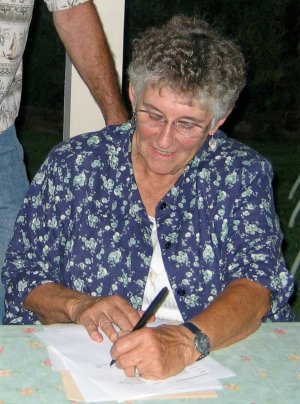I failed. My failure was total and easily achieved, although completely unintentional.
My friend Jessica mentioned how she was avoiding artichokes because they were so fattening with all of the mayonnaise that she uses with them. I suggested eating them with melted butter with lemon, the favorite accompaniment in our house.
Then in the back of my mind I thought, “Artichokes are healthy and nutritious; why do we always have to serve them with fatty dipping sauces? I can come up with something healthier.” So I started thinking ...
Many people think of artichokes as “fancy food” and eat them only on special occasions, but artichokes are low in calories (60 per average), full of fiber (12 percent of your daily requirement), vitamin C (10 percent of the daily requirement), they’re higher in antioxidants than 993 out of 1,000 other fruits, vegetables, nuts and other foods tested – that’s right SEVENTH highest in antioxidants!
They also have properties that fight cancer, heart disease and harmful cholesterol, and studies are being done that look at how the artichoke may help the liver regenerate. They are a non-starchy vegetable so they are safe for diabetics. Artichokes should be a staple to your diet, not a specialty item.
The origin of artichokes has been lost to history. Some people think they were most likely developed from the cardoon plant by the Romans or the Greeks. There are ancient tile frescoes in Roman ruins that show flowering cardoon plants with small artichoke like flowers. Cardoons and artichokes are closely related, and some people think that cardoon is the artichoke’s forefather, and some vice versa. There is a wild version of artichokes that grows in North Africa. The only thing that we know for sure is that the artichoke originated around the Mediterranean Sea.
The first written mention of artichokes growing comes from Greece and dates to around 300 BCE. When I finally invent my time machine I will definitely go back and find out all of the facts on the artichoke’s origin, and I will correct this article accordingly when I get back.
Queen Catherine de Medici is credited for having brought artichokes to France from her Italian homeland, and her excessive eating of them and feeding them to king Henry II was thought of as scandalous by courtiers. In those days artichokes were considered such a powerful aphrodisiac that only men were allowed to eat them (it’s good to be the king). There are even references that overeating artichokes disturbed the digestion of the Queen Mother after a wedding feast. Wow, talk about interesting historical documents, we don’t know where Jimmy Hoffa is but we know about a member of the royal court in the 1500s having the trots.
Speaking of Jimmy Hoffa (not really, but you’ll get the idea) ... In the 1920s Mafia monopolies and “the artichoke wars” prompted the then-New York Mayor La Guardia to make the artichoke completely illegal in New York City. Only his love for the delicious flower bud caused the law to be rescinded a week later.
California supplies nearly 100 percent of the country’s artichokes. Although the “Green Globe” variety makes up most of the artichokes available on the market both at the supermarket and garden center, there are several different varieties.
The artichoke doesn’t grow well from seeds so most are grown by propagation from existing plants (think of it as God’s cloning). This however is dangerous because it makes most of the artichokes in California so closely related that one good disease could almost eliminate the entire country’s artichoke supply (remember the Irish and the potatoes?).
There are at least 140 different varieties of artichoke but only around 40 are commonly cultivated worldwide. Other varieties include “Anzio” (Italian commercial), “Big Heart”(U.S. commercial), “Campania” (French commercial), “Catanese” (Italian commercial), “Desert Globe”(U.S. commercial), “Fiesole” (French commercial), “Imperial Star”(U.S. commercial), “Purple Italian” (U.S. home garden), “Violetta” (U.S. home garden), “Purple Roscoff”(U.S. home garden) and “Lyon” (French commercial).
I grow my own artichokes, a rare heirloom variety called Romanesco (Italian commercial). If you want to grow your own, you need to know that artichokes like rich soil and cool temperatures. This is why they love Castroville; it has the cool coastal air year-round.
Here in Lake County the summer temperatures are somewhat extreme and will make artichokes wilt to the ground. In order to avoid this sad look in my yard, in the spring I harvest the last of the artichoke flowers and give the plant a few more weeks to grow. But the moment the plants start to whine and shows any sign of distress from the heat, I hack them to the ground with a machete until there is nothing but a stump poking out of the ground. I keep the soil heavily mulched and moist during the summer and the plants survive and completely bounce back when cooler weather returns.
Artichokes contain a natural phytochemical “sweetener” called cynarin, and studies are being done to make it a commercially available product. If you want to do an interesting experiment to test the sweetener in an artichoke do this. Cook an artichoke and pour yourself a glass of wine – any wine will do. Before you taste any of the artichoke, try a sip of the wine and take note of the flavor. Then eat some of the artichoke and immediately sample the wine again. You will notice that the wine has a completely different taste, so much so that you will think that it is a completely different glass of wine. The cynarin left over in your mouth reacts with the sugars in the wine and change the taste. This effect is one of the reasons that restaurants that serve expensive wines don’t serve dishes with artichokes.
The myth of how artichokes came to be tells how Jupiter/Zeus (whether you are reading the Roman or Greek version) came to lust for a beautiful girl named Cynara and took her as a mistress to Mt. Olympus. When she became homesick and snuck off to visit her mother, the god of thunder became enraged and hurled her back to earth as the artichoke plant. The artichoke’s Latin name commemorates this – Cynara scolymus.
So how could I fail while dealing with this fantastic plant? Well, I wanted to make a healthier dipping sauce for artichokes, but all I managed to do is shorten my life by clogging my arteries with cheese. This is now my wife’s new favorite dipping sauce for artichokes. I’ll head back to the drawing board.
Parmesan cheese dipping sauce
1 tablespoon butter
1 tablespoon flour
1 cup milk
½ cup sour cream
6 ounces shredded Parmesan cheese (as little as 5 ounces will work)
2 tablespoons white wine
White pepper to taste
Put the butter and flour in a pot on medium heat. As the butter melts whisk the flour together so you get a paste. Continue cooking this for about two minutes; the color should change very slightly to a blonde highlight.
Although it’s not necessary, I recommend you microwave the milk for 30 seconds. This will keep the splattering down as you add it to the butter/flour mixture (called a roux).
Add the milk slowly to the roux, whisking constantly to combine. The mixture will start to thicken fairly quickly, so reduce the heat to low at this point. Sprinkle in about one-third of the cheese, whisking constantly. You want the cheese to melt as slowly as possible, because melting quickly will cause the cheese to clump up and make a poor sauce.
Stir the cheese mixture until all the cheese is melted and then add another third in. Whisk until that’s melted and then ... that’s right, add the final third and whisk until melted. Then add the sour cream, wine and pepper. Mix thoroughly and then ladle into dipping cups. Serve with cooked artichokes.
Ross A. Christensen is an award-winning gardener and gourmet cook. He is the author of "Sushi A to Z, The Ultimate Guide" and is currently working on a new book. He has been a public speaker for many years and enjoys being involved in the community.
{mos_sb_discuss:4}









